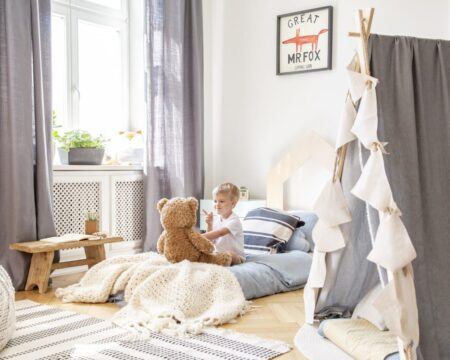Dr. Harvey Karp’s secrets to sleep training a toddler
I’m Dr. Harvey Karp, a pediatrician and author of the bestselling books The Happiest Baby on the Block and The Happiest Toddler on the Block. I’ve spent my entire career not only helping children sleep—and sleep safely—but empowering parents with the tools they need.
Got an energetic tot who resists bedtime? You’re not alone! Toddlers often dislike the idea of putting all their moving, learning, and exploring on hold for boring ol’ bedtime. They’d much rather stay up and see what you’re up to. At the same time, it’s normal for toddlers to go through periods of fearfulness, suddenly worried about the dark or being alone in their room. No matter what’s keeping your tyke from sleeping, here are some toddler sleep training tools to help them get the rest they need.
Set your toddler up for sleep success
Toddlers thrive on order and routine. That’s why it’s important to establish a predictable and calming bedtime routine that begins about an hour before you turn out the lights. Stop all roughhousing, turn off screens, dim the lights, and turn on low and rumbly white noise. With continued use, your tot will start to recognize that all these things signal that bedtime is near. Plus, white noise works wonders at distracting tots from common internal sleep-stealers, like teething pain, and external disruptors, like a too-loud TV.
Another important sleep-training helper: The lovey. Loveys, like a soft teddy bear, can give toddlers the comfort, confidence, and security they need to successfully go to sleep…and stay asleep. Even the American Academy of Pediatrics notes that every child “needs” a comfort object in their early years for emotional support.
It’s science: Your child’s favorite lovey fosters independence
Create and read a bedtime book
Children like to know what’s expected of them, so to help them understand their role at bedtime, create a personalized book with photos that illustrate a typical day in your tyke’s life, including all the steps of their bedtime routine. Read it together regularly to help your child know what they’re to do when it’s time to hit the hay.
Dole out “special passes”
If your toddler is (supposed to be) sleeping in their own bed, but routinely gets out and crawls into yours—or yells for you to come back—offer “special passes.” Say something like, “When I tuck you into bed, I’ll give you two special passes.” Then place the passes, like paper cut-outs or poker chips, near their bed. “If you call me back to visit you for water or an extra kiss, or for any reason, I’ll come fast—but you have to give me one of your passes.”
The kicker: In the morning, if your tot still has at least one pass, they can exchange it for a special gift, like a sticker or a temporary tattoo! If they have two passes, they get an extra special prize, like a special lunch out with Dad. This trick works best with older toddlers.
Related: 5 ways to create a bedtime routine for your toddler
Offer a gentle exit
If you’ve got a toddler who demands you stay with them till they fall asleep, try the “Twinkle Interruptus” strategy: When you’re just about ready to give good-night kisses, suddenly say “Oh gosh! Wait! Wait! Just one second! I need to check on something! I’ll be right back!” Leave the room for a few seconds and come back.
When you return, praise your toddler for waiting. Next, read a few pages from their bedtime book and once again make an excuse for why you need to leave (“Uh-oh! I need to go potty! Give your lovey a big hug and I’ll be right back.”). When you repeat this a few times, gradually increasing the waiting interval, over several nights your toddler will likely fall asleep while waiting a minute or two for your return.
Related: What to do when your toddler needs a nap but won’t take one
Use Toddler-ese
Do tantrums flair at bedtime? Speak to your upset tot in Toddler-ese, which is a style of talking that combines your tot’s native tongue (short phrases and repetition) with you mirroring about one-third of your child’s feelings with your tone of voice and gestures. (“You’re mad! Mad! Mad that it’s bedtime!”)
Once your little friend is allowed to safely express their feelings—and you acknowledge those feelings—they’re better able to hear what you have to say.
Related: 8 expert tips for managing the toddler sleep regression
Try the “Pick Up, Put Down” method
If you need a more direct method of sleep training your toddler, try the “Pick Up, Put Down” sleep training method. Here, you do your regular bedtime routine—including using strong, rumbly white noise—and sit quietly next to your toddler’s bed. Then, respond to your tot’s cries by picking them up and cuddling—but only until they calm down. Stay in the room until your toddler falls deeply asleep.
Then, over the course of several days, as your toddler gradually cries less and less, move your chair farther from the bed… and closer to the door. (This works well when coupled with “Twinkle Interruptus” above.)
In the end, it’s important to remember that toddler bedtime turmoil may seem endless, but it’ll be over soon. Stay focused on your goal, take lots of deep cleansing breaths, and remind yourself that toddler parents all over the world have survived this experience —and you will too!























